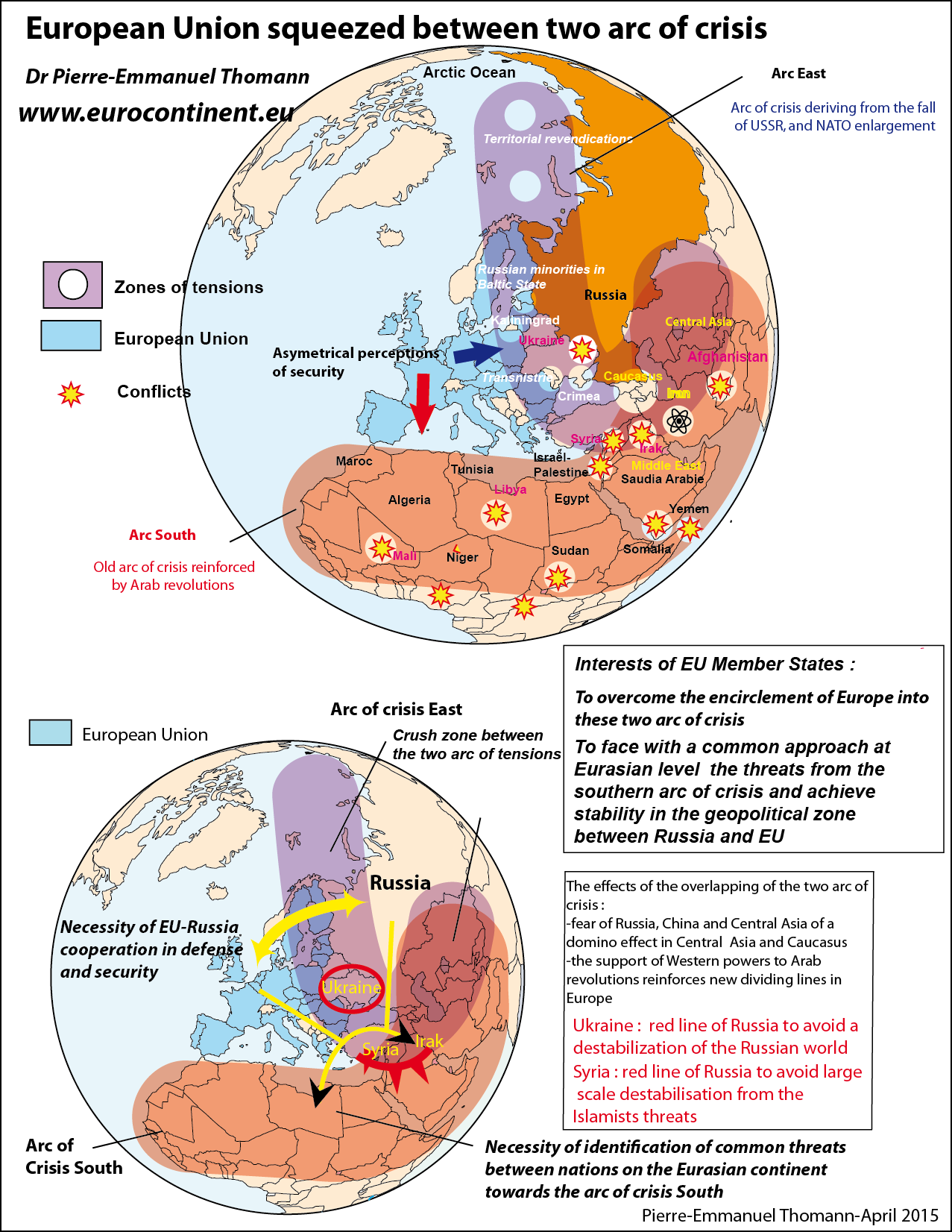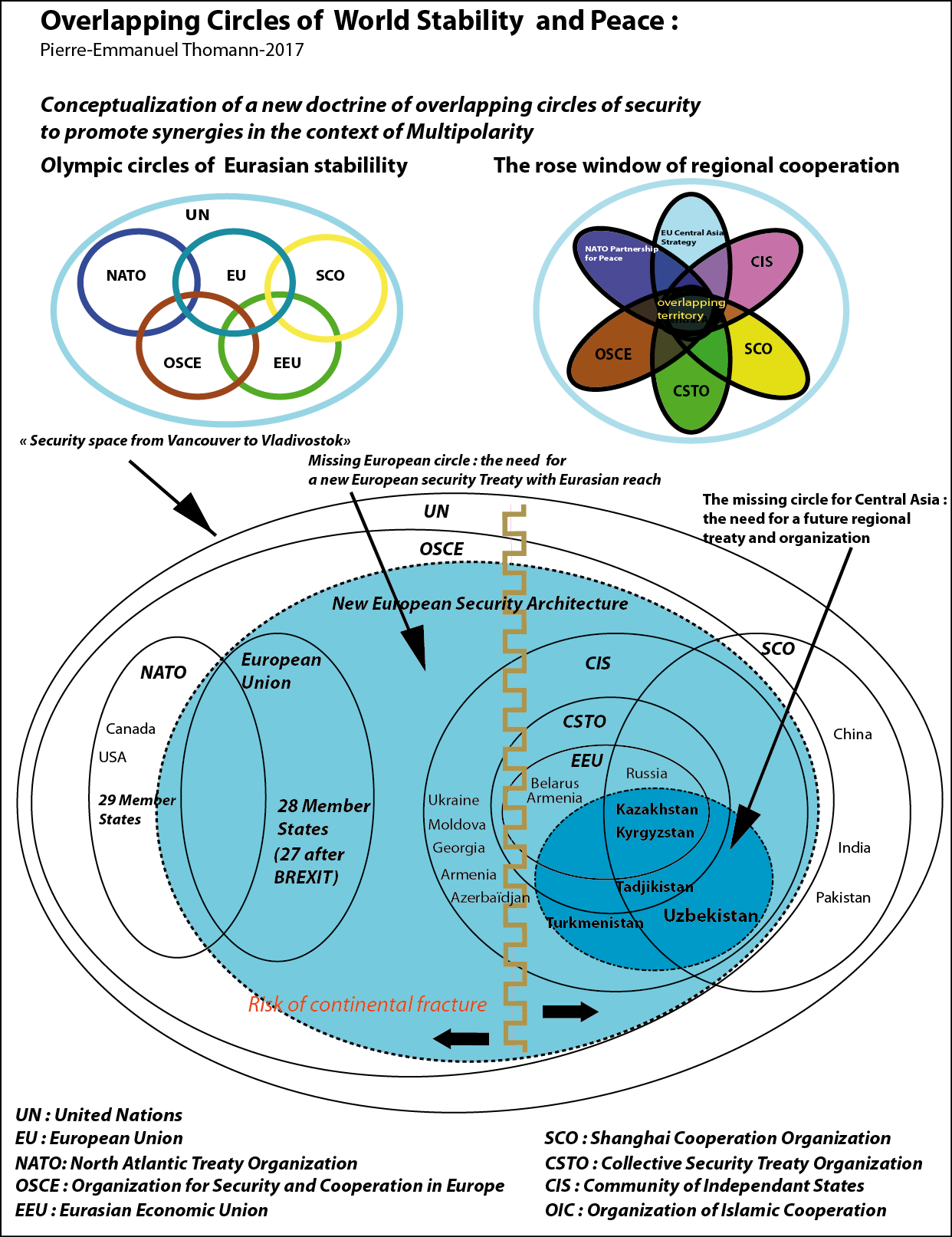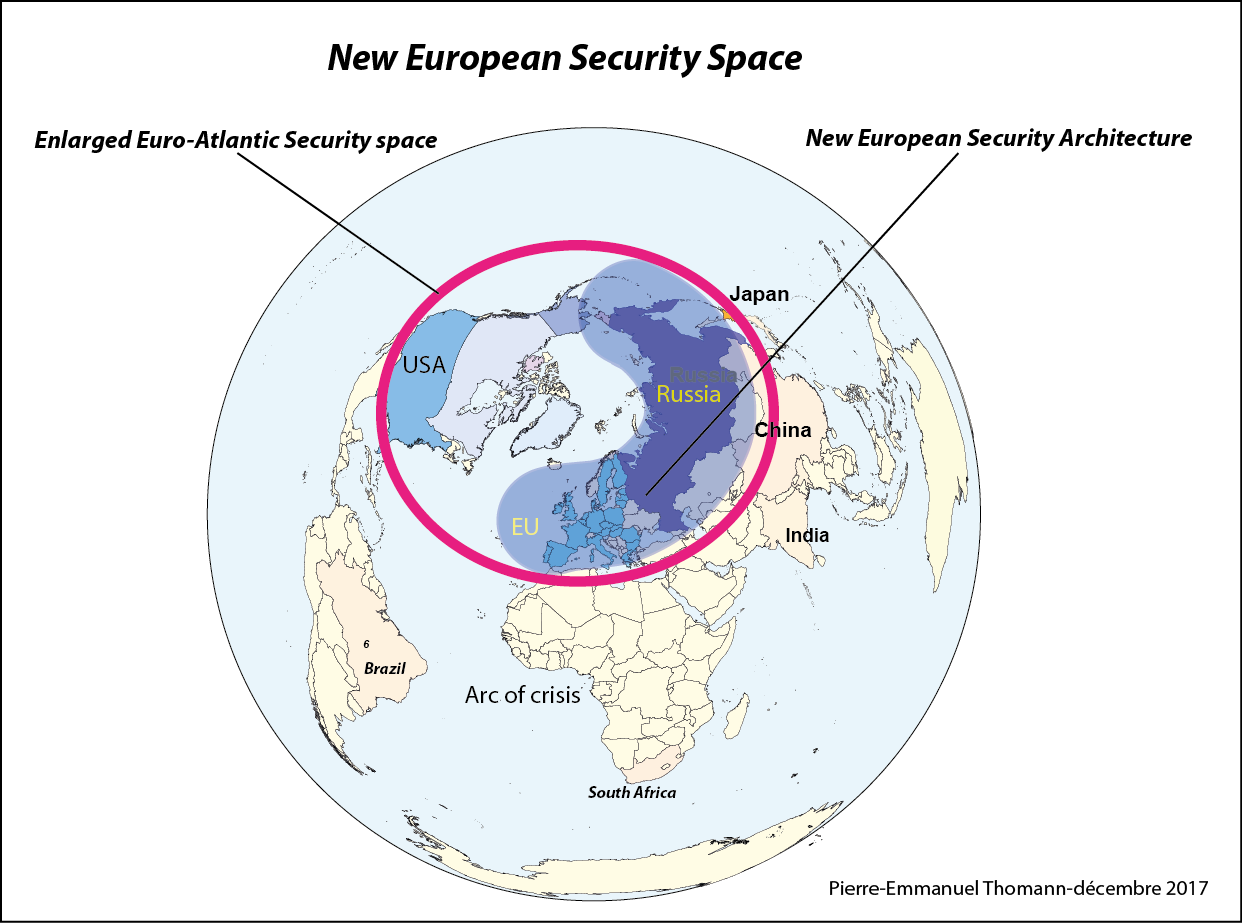
Prospects for a new European and Eurasian security architecture
The European security has not improved yet since Europe is squeezed between two arc of crisis. Islamist security threats are coming from a wide zone of instability from Morocco to Afghanistan. This arc of crisis situated on the South of Eurasia is also reinforcing the arc of crisis fracturing the European continent with the crisis between EU and Russia. The improvement of security and stability in Eurasia is a common geopolitical objective shared by EU and Russia, but it requires more accurate and shared global geopolitical diagnosis and a more systemic response. This requires to overcome the EU-Russia crisis, but the EU « selective engagement » principle introduced after Ukraine crisis in 2016 is not enough. EU would like to cooperate with Russia on Afghanistan, but Russia is expecting a much wider negotiation on the European security architecture. The situation and necessary synergies will therefore not improve with separate negotiations between EU and Russia on the different conflicts like Afghanistan, Donbass in Ukraine, frozen conflicts in Moldova, Georgia, but more likely with a global negotiation on a New Eurasian geopolitical architecture. This requires a reform of the EU in order Europeans identify their own geopolitical interests with Russia, according to their own geography.
Here is the diagnosis and policy recommendations :
The missing link of global security: a New Eurasian geopolitical architecture
According to the “selective engagement” of the EU principles towards Russia, Europeans are willing to cooperate with Russia on specific thematics where common interests are identified in the wider context of difficult sanctions and rival narratives regarding the different crisis. However, there is the hope from the EU side that the different local and regional crises could be progressively resolved, like the Afghan, Ukrainan but also the Georgian and Moldavan crises labeled as frozen conflicts. However, it is an illusion to think these different crises can be resolved on an individual basis since they are all part of a wider systemic crisis between the rival Western and Russian visions. More global negotiations at continental level on respective red lines are more likely to change the context of rival vision. The regional crises could be resolved as part of a more systemic arrangement.
The “selective engagement” principle can be a useful instrument for gaining trust in negotiating confidence building measures but cannot resolve the overall geopolitical situation at the origin of the crisis.
That is why a new European security architecture is the key to local and regional crises and not from the other way round, from local and regional to global. A new European security treaty at the Eurasian level is therefore the missing link in European security in the context of the emergence of the multipolar world, and in the face of the risk of a deepening rift between Euro-Atlantic alliances and emerging alliances in Eurasia.
However, it is illusory to believe that relations between the EU and Russia will resume in the same format that prevailed before the Ukrainian crisis in the fluid world of today. Russia will never accept being integrated into a Euro-Atlantic entity as a subordinate element. Russia will not abandon its Asian orientation because the emerging geopolitical center of gravity of the world is Eurasia. Russia’s pivot to the East (Karaganov 2016) is here to stay, and will hopefully be accompanied by a resetting of relations with western Europe, but only in case of EU reform. The Greater Eurasia partnership or community Russia is looking for is a common space for economic, logistic and information cooperation, peace and security from Shanghai to Lisbon and from New Delhi to Murmansk (Karaganov 2016). The security dimension is the most important for Russia as it cannot compete with Asian giants in the economic sphere but has a competitive advantage as a security provider. This function has to be recognized by EU member states since they will equally profit from it.
Contrary to some alarming narratives in the West, the pivot to the East, according to Russia, is not to turn its back to Europe. The pivot to the East is not only geared to China but also other Asian powers, and it is also viewed as a balancing act towards China in order to work on a “constructive counterbalance to China to make sure it does not become ‘too strong’ or turn into a potential hegemon scaring its neighbors” (Karaganov 2016). Since the world is in a fragmenting process, there is excessive fear of the re-emergence of a world of blocks. Russia played an important role in the European balance of power for centuries, and this role is just making its return, since the block policy of the Cold War time, although some actors would like to revive it, would be difficult to implement. Thus, if Europeans fear a Russian-Chinese alliance and an excessive orientation of Russia towards Asia, EU member states have to pivot towards Russia in order to maintain a strong European continental link. This is rational geopolitics. However, with EU sanctions against Russia, the EU is lagging behind geopolitical maneuvers. The European project is wasting time by insisting on old paradigms, while Russia is moving faster. The potential European project pivot to Eurasia would be essentially a pivot to Russia in order to gain more weight and adopt a Eurasian geographical scale. Russia is culturally part of Europe and this will still be the case in the future. The EU has again lost an opportunity in its communication Connecting Europe and Asia ‒ Building Blocks for an EU Strategy (European External Action Service 2018), since the reference to the Eurasian Economic Union is absent, although Russia is the geographical link between Europe and Asia.
The European project will have to be reformed, according to the lessons to be drawn, in particular regarding the thematic of the external relations. This objective seems to be shared in a still shy way by the German and French governments. A new security architecture with Russia is the goal announced by French president Emmanuel Macron (Elysée 2018), while the German government’s coalition treaty (Bundesregierung 2018) mentions a “Europe from Lisbon to Vladivostok” as an economic objective. The conditions laid down for the German and French governments to advance on this path, the prerequisite for strategic autonomy for the European Union in terms of defense and security, and the implementation of the Minsk agreements by Russia, while Ukraine is largely responsible for the blockage, however, are unrealistic and therefore constitute obstacles.
Future crises that will affect the entire European and Eurasian continent may have the effect of lifting the current barriers. The extension of the Euro-Atlantic security system and the normative and integrationist vision of the European Union to Russia is unachievable. The European Union has entered a process of geopolitical fragmentation whose outcome is uncertain, with east-west, north-south divides, an uncertain Brexit process and a new Franco-German geopolitical rivalry since German reunification. Russia could not, even if it wanted to, align itself with the normative and political model of the European Union, which has become less attractive and will necessarily evolve in the coming years (Kortunov 2018). The doctrine of balance of power and cooperation led by nation states are more realistic for the future stabilization of the European continent.
In a multipolar world, stability in Eurasia can only be achieved by a balance among the great powers, and not by a fixation on the doctrine of “enlargement of democracy,” which serves as a pretext to weaken Russia and leads to the reinforcement of reciprocal mistrust. Russia serves as a useful counterbalance in the context of a global equilibrium policy. It is also the energy and commercial hinterland of the European Union. The possibility of a strategic partnership between a reformed European Union and Russia must therefore be safeguarded.
This continental alliance is also necessary to rebalance the overwhelming weight taken by the political and economic forces that precipitate a process of globalization characterized by an anarchic development of the financial, commercial, cultural and information networks that destroy the continental solidarities through the insufficiency of the filters at the national and European borders. The risks and threats for European companies today are internal and financial. They result from the communitarization of societies and a decomposition of the social fabric due to the loss of control of financial flows and uncontrolled mass immigration. A common approach to these topics would be welcome.
The new emerging multicentered world (Russia and its European and Eurasian dimensions, western Europe and its Atlantic and continental dimension, the USA and its Atlantic and Pacific dimension, China and its Asian and Pacific dimensions) is giving opportunities to all actors, and diversity, balance and fluidity in alliances, according to geography and thematics, represent the best scenario for the future, since the re-emergence of blocks and rigid alliances, like during the Cold War, makes the scenario of World War III more likely. Again here strategic communication can make new visions emerge, and balance reactionary and obsolete antagonistic visions. Then, efficient multilateralism might emerge after an acceptable new balance of power among a reformed EU, the US, Russia and China.
The new Eurasian security architecture
Konrad Adenauer, the first Federal Chancellor of West Germany, insisted on the primacy of foreign policy objectives over national domestic policy agendas (Adenauer K. 1965). Following this adage, let us first examine global-scale issues before we look at more regional issues
There are missing links in the security architecture of the European, Eurasian and central Asian spaces that need to be filled in order to avoid a further fragmentation of the European continent between Euro-Atlantic and Euro-Asian alliances (Thomann 2013). The EU can neither represent the whole of Europe in an exclusive way, nor can it extend itself to the Eurasian continent. It would therefore be interesting to imagine a new network of treaties and institutions resembling the “Olympic circles,” which would allow stability to be maintained on the whole Eurasian continent. What could this new geopolitical architecture look like?

There is a need for a new European security treaty with a Eurasian reach, and a new “Central Asian Partnership and cooperation mechanism” in the context of an emerging global and European multipolar feature.
Synergy is needed among the various actors to achieve geopolitical stability on the Eurasian continent. From a long-term perspective a new Eurasian geopolitical architecture based on a new doctrine of overlapping circles of international organizations would be a major factor in developing and improving Eurasia.
We also have to assume that an enlargement of Euro-Atlantic institutions (NATO-EU-OSCE) to the whole of the Eurasian continent is impossible. Firstly, the individual EU and NATO member states disagree on further enlargement. Secondly, it would be impossible for these Euro-Atlantic institutions to manage the geopolitical diversity of the Eurasian continent.
This new security architecture is based on the “geographical tightening” principle in the context of NATO’s and the EU’s overstretched capacities. Geographical proximity would be a central criterion for building regional alliances in order to foster stability and prevent any further Eurasian fragmentation.
A new “security space” from Lisbon to Vladivostok would be the inner circle of a wider Euro-Atlantic security space from Vancouver to Vladivostok, based on a balance of interests and no longer on the westernization of Eurasian space (see Figure : New European security space).

In this configuration, we would find the reformed EU as a pivot/political center and Russia as a neighboring pivot/political center at the crossroad of overlapping security spaces from Vancouver to Vladivostok (NATO and OSCE, USA-EU-Russia), Lisbon to Vladivostok (EU-Russia), St Petersburg to Peking (OCS), Minsk to Dushanbe (OTSC) and Murmansk to New Delhi (BRICS).
Cooperation policies and “nonaggression agreements” would need to be negotiated among these geopolitical spaces. This network of institutions resembles the “Olympic circles.” The described configuration would be adapted to the emerging multipolar world to maintain a balance among the different states, alliances and political as well as security institutions. This architecture is aimed at promoting synergies between interleaved organizations like NATO, the EU, the OSCE, the CIS, the CSTO, the EEU, the OIC and the SCO[1] and should lead to greater levels of stability. In-between spaces between these structures would be subject to common stabilization policies or “nonaggression agreements.”
The stability of Eurasia could therefore be improved with this new synergy between international organizations, but the prerequisite is a better geopolitical balance of power between actors and the acceptance of multipolarity by the US and European allies.
This new doctrine of “overlapping circles” supposes the acceptance by international actors of the emergence of a variety of international organizations whose objectives contribute to Eurasian and world stability. For example, the strengthening of the SCO should not be perceived in the West as a geopolitical rival, but as a future partner to manage the multipolar world. It is in the long-term interests of Euro-Atlantic structures, the EU, the OSCE and NATO to be complemented by other international organizations like the CIS, the CSTO, the EEU, the OIC and the SCO in order to stabilize the Eurasian continent.
Russia is promoting multipolar features, and this is compatible with a European project striving for more strategic autonomy, but also the new approach of the United States under the presidency of Donald Trump, if he succeeds in convincing his own administration to reduce American presence on the global stage.
Within a new Eurasian security architecture, a resetting of relations between a reformed European project and Russia is aimed at assigning to the EU and Russia a moderating and restraining role so as to avoid a global US/China confrontation and further fragmentation between Euro-Atlantic and Euro-Asian alliances. The idea is to avoid being drawn into this confrontation and forced to choose a camp, and to avoid a US/China condominium (G2) sidelining the EU and Russia in global affairs.
Conclusion :
A central issue is therefore how would it be possible to achieve a better geopolitical balance among the different states, the emerging and old alliances and security institutions to overcome the increasing fragmentation. Negotiations can be engaged using the OCSE dialogue and co-operation methods, since OSCE covers Vancouver to Vladivostok space. An inner circle, Lisbon to Vladivostok has also to be fixed, with another institution. The crisis between the EU and Russia is not a sub-element of the EU’s external relations but is part of the deeper crisis of the aims of the European project. It is probably an illusion to think that the EU and Russia will be able to resolve their different disputes using a “one-by-one” crisis approach on a “sectoral basis.” Linkages in negotiations (Kissinger doctrine) cannot be applied that way.
The long-term objective of improving EU-Russia relations implies offering each other an acceptable place in our respective projects: Russia should be given a role in the European project, and the European project should be given a role in the Russian vision. Only then might the different ongoing crises have a chance of being resolved in a more global deal.
Ultimately, this cooperative option would require negotiating new and sui generis structures to institutionalize this long-term vision of a “Europe from Lisbon to Vladivostok”
[1] North Atlantic Treaty organization (NATO), European Union (EU), Organization for Security and Cooperation in Europe (OSCE), Community of Independent States (CIS), Collective Security Treaty Organization (CSTO), Eurasian Economic Union (EEU), Organization of Islamic Cooperation (OIC), Shanghai Cooperation Organization (SCO).